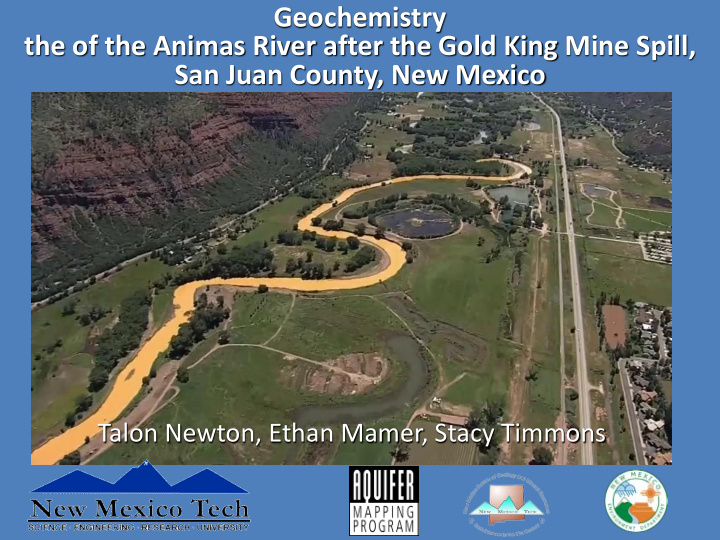



Geochemistry the of the Animas River after the Gold King Mine Spill, San Juan County, New Mexico Talon Newton, Ethan Mamer, Stacy Timmons
Gold King Mine Spill • August 5, 2015 • ~3 million gallons of mine-waste water, and 540 tons of mine-waste sediment were released into the Animas near Silverton, CO – Dissolved contaminants flowed past Farmington within a week of the spill – Contaminated sediments were deposited and left behind • Immediate Response – Collaborative data collection (USEPA, USGS, NMED, NMBGMR, NMOSE) – Water levels in over 100 wells – Water samples collected from private domestic wells
Groundwater study • Water levels • Manual • Continuous • Water Chemistry • Field parameters • Major ions • Trace Metals • Environmental Tracers
Objectives • Characterize hydrogeologic system – Recharge components – Flow directions – Important hydrogeologic and geochemical processes • Assess impacts of GKM spill to shallow groundwater – Potential for impact – Identify evidence of impact
Potential interactions and processes that affect groundwater quality
Regional Geology • Nacimiento Formation (~60- 65 Ma) – fluvial sandstone and gray shale • Kirtland Shale (~75 Ma) – siltstone, shale, claystone, and sandstone
Sampling schedule
Sample locations
Spatial trends
Controls on water chemistry • Water/mineral interactions – Dissolution of limestone and gypsum – Cation exchange • Mixing of river water with Sulfate Calcium regional groundwater Bicarbonate
Irrigation recharge
Regional recharge
Mixing model
Water quality • Secondary maximum contaminant level (SMCL) – non-enforceable guideline regarding cosmetic or aesthetic effects • High TDS due to high solubility of calcite and gypsum • High sulfate due to mixing of regional groundwater **The USEPA water quality standards discussed are provided simply for comparison of privately owned domestic well water samples and are not enforceable for private wells
Gold King Mine spill USEPA SMCL Minimum Median Maximum % non- (mg/L) detects Iron 0.3 0.022 0.274 3.34 50 Manganese 0.05 0.001 0.016 6.48 23 Aluminum 0.05 0.0005 0.0007 0.161 50 Lead 0.015 (AL) - - - 100 Copper 1.0 0.0005 0.0014 0.018 12 Arsenic 0.01 0.0005 0.0031 0.0051 89 Zinc 5 0.0005 0.0076 0.0466 2 Cadmium 0.005 (e) - - - 100 Mercury 0.002 (e) - - - 100
Geochemical conditions
Impact of the Gold King Mine spill • No evidence of impact to groundwater quality – Limited “before the spill” chemistry data for comparison – Constant leakage of contaminated water from headwater region – Metals of concern exist naturally in aquifer • Due to geochemical conditions (pH, Eh), impacts to groundwater quality are unlikely • Contaminated river sediments in irrigation ditches may still pose a threat
Future work • Continued monitoring – Specific areas of concern – Methods of assessing processes of interest • More research to better understand controls on redox conditions – Why do manganese and iron concentrations vary spatially? • Differentiate mine water sources from in-place aquifer sources
Acknowledgments Very kind landowners • • NM Environment Department - Dennis McQuillan, Diane Agnew, Patrick Longmire, Kris Pintado • U.S. EPA – Funding to NMED • USGS - Jesse Driscoll, Lauren Sherson, Nicole Thomas, Amy Gallanter NMOSE – Doug Rappuhn, Rob Pine, • Shawn Williams • NMBGMR/NMT - Trevor Kludt, Scott Christenson, Kitty Pokorny, Brigitte Felix, Sara Chudnoff, Bonnie Frey, Dustin Baca, Geoff Rawling, Mark Mansell, Kylian Robinson NM Bureau of Geology and Mineral Resources NM Bureau of Geology and Mineral Resources
Recommend
More recommend